While no climate change analysis was carried out on the open stormwater system, it was designed to accommodate a 15 year rainfall event as the baseline, which also serves the purpose of adaptation to increased precipitation in the future. The project involved retrofitting SUDS within existing development and infrastructure, and with residents in situ.
The completed stormwater management system includes a total of 6 km of canals and water channels and ten retention ponds. Rainwater is collected in natural ditches and reservoirs and then the surplus is directed to a conventional sewer system and a nearby watercourse. The rainwater from roofs, roads and car parks is channeled through visible trenches, ditches, ponds and wetlands. These landscape features are integrated into the townscape within 30 courtyard areas, which also provide recreational green spaces for the area’s residents. Whilst green spaces were increased in size and number, the specific style of the 1950’s was maintained so as not to compromise the aesthetics of the area. Some of the green spaces can be temporarily flooded, which helps to manage water by slowing its entry into the conventional stormwater system.
Supplementing the sustainable drainage system, there are more than 11,000 m2 of green roofs in the area, including 2,100 m2 on the buildings of the public housing company MKB and the 9,000 m2 of the Botanical Roof Garden that has been built on an old industrial building. In the regeneration project, launched in 1998, green roofs were installed on all new developments (built post 1998) and retrofitted on some older buildings, such as garages that have been turned into offices. Some newer green roofs have been installed also after the regeneration project.
As a result of the implementation of the open stormwater management system, many floods have been avoided in the area. It suggests that the design of the open stormwater system is performing better than a conventional system and that Augustenborg is well prepared for more intense rainfall events also in the future. In the summer of 2007, a 50-year rainfall event caused severe problems in most of Malmö by flooding access roads, but Augustenborg was unaffected. Again in 2014, severe flood-damages and repair cost were avoided in Augustenborg during a heavy rainfall event with over 100 mm of rain in 6 hours. Additionally, many smaller heavy precipitation events have been handled well by the open stormwater system.
It is estimated that 90% of the stormwater from the rooftops and other impervious surfaces is led into the open stormwater system. In addition, the total annual runoff volume is reduced by about 20% compared to the conventional system. This is due to evapotranspiration from channels and retention ponds between the rain events. Also, the runoff peak flows are delayed and attenuated. The implementation of an open stormwater system at Augustenborg has improved not only stormwater management in the area, but also the performance of the combined sewer system that serves the surrounding area. The volume of stormwater draining into the combined system is now negligible, and this system now drains almost only wastewater.
The alternative option of reducing flooding via a conventional separated stormwater system for Augustenborg would have meant major earthworks. This approach could also have caused problems further along the stormwater drainage network, such as bottlenecks where the system joins with older pipes. Moreover, the receiving areas could have suffered increased flood risk, erosion or water quality degradation. Therefore, the implementation of the open stormwater system was considered to be the most sustainable option aligning with the vision of the regeneration initiative Ekostaden Augustenborg.



